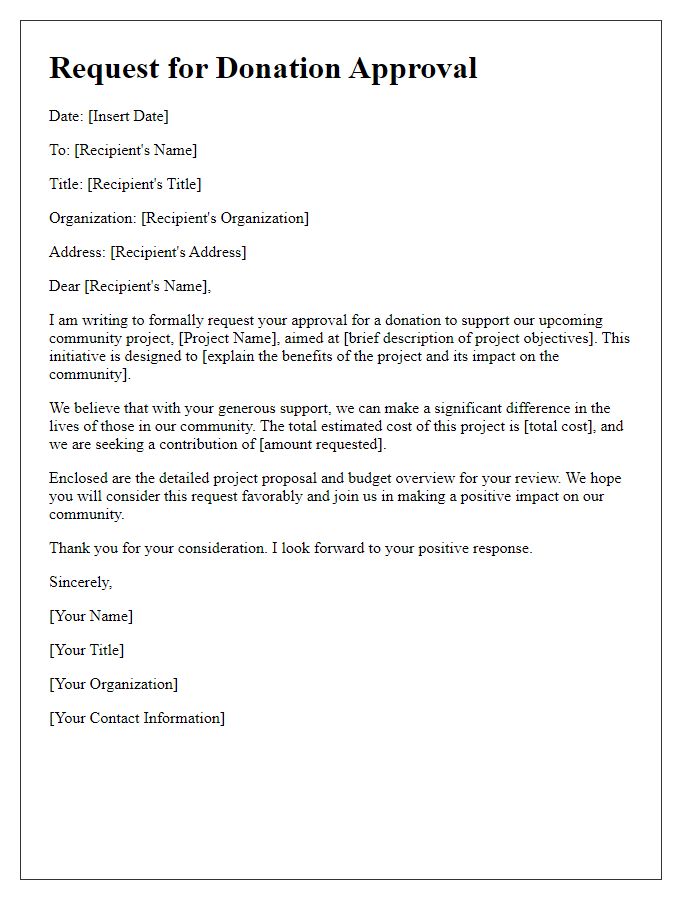Are you looking to make a positive impact with your donation request? Crafting the perfect letter is essential to inspire generosity and secure the support you need. In this article, we'll explore effective strategies to articulate your cause compellingly and respectfully, ensuring your request resonates with potential donors. So, let's dive in and discover how to write a donation approval letter that truly stands out!

Purpose and Mission Alignment
A request for donation approval should emphasize alignment with organizational purpose and mission. For a non-profit organization aiming to support underprivileged children, for instance, highlighting previous events such as educational workshops or community outreach programs is essential. Concrete examples of past successes, like distributing 5,000 backpacks in 2022 to local schools in Chicago, could illustrate impact effectiveness. Detailing the current initiative, such as a plan to fund a literacy program to benefit 300 children in the upcoming school year, can demonstrate commitment to mission objectives. Specific goals, including raising $50,000 by December 2023 to implement these programs, should be clearly stated to establish urgency and importance. Engaging potential donors by showcasing statistics about community needs helps in making a compelling case for support.
Target Audience and Engagement Strategy
Crafting a targeted audience engagement strategy is crucial for effective donation requests. Identifying potential donors, such as community leaders, local businesses, and philanthropic organizations, enables tailored communication that resonates with their interests. Engaging through social media platforms like Facebook and Instagram allows for broader outreach, showcasing impactful stories that highlight past successes. Hosting events, such as charity dinners or community clean-up days, can create personal connections and demonstrate tangible outcomes of donations. Utilizing email campaigns with compelling narratives and clear calls to action enhances the likelihood of contribution. Acknowledging donor contributions through public recognition, such as on a dedicated website section, reinforces the value of their support and encourages future donations.
Fund Usage and Transparency
The request for donation approval highlights the importance of fund usage and transparency in nonprofit organizations. Donors seek assurance that their contributions, often exceeding thousands of dollars, will be allocated effectively to support community programs (such as educational initiatives, food assistance, or healthcare services). Detailed reports on budget allocation (including percentages for administrative costs, program expenses, and fundraising) enhance trust. Organizations can implement transparency measures, such as public financial statements and impact assessments, to foster donor confidence. Establishing a clear communication strategy can also facilitate ongoing engagement with potential donors, demonstrating accountability and commitment to mission-driven outcomes.
Authenticity and Credibility
Nonprofit organizations heavily emphasize authenticity and credibility when requesting donation approvals. Organizations like The American Red Cross (established in 1881) often provide transparent financial statements, detailing revenue sources and expenditures to ensure trust among donors. Credible endorsements from reputable figures or institutions can enhance the organization's image, leading to increased donor confidence. Additionally, verified testimonials from beneficiaries highlight the impact of donations, showcasing specific projects such as disaster relief efforts or health initiatives. By maintaining open communication and providing regular updates on how donations are utilized, organizations can further solidify their reputation, ultimately fostering lasting relationships with contributors and enhancing future fundraising efforts.
Impact Measurement and Reporting
Impact measurement reports in nonprofit organizations assess the effectiveness of funded programs. These reports typically include quantitative data metrics such as the number of beneficiaries (often ranging from hundreds to thousands), qualitative feedback through surveys or testimonies, and case studies representing individual success stories. Financial transparency, which involves detailed budgetary breakdowns and funding allocation percentages, enhances credibility among donors. Reporting often follows specific timelines, such as quarterly or annual updates, ensuring compliance with donor expectations. Utilization of data visualization tools can depict progress clearly, making impactful narratives more accessible. Comprehensive impact measurement not only shows accountability but also demonstrates the tangible benefits generated from donations, encouraging further support for ongoing initiatives.
Letter Template For Request Donation Approval Samples
Letter template of donation approval request for health awareness campaign

Letter template of donation approval request for environmental conservation

Letter template of donation approval request for disaster relief efforts











Comments